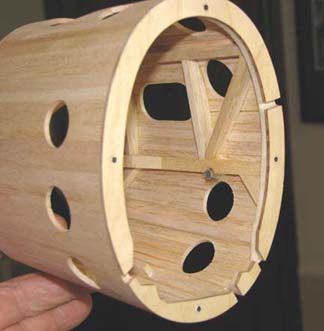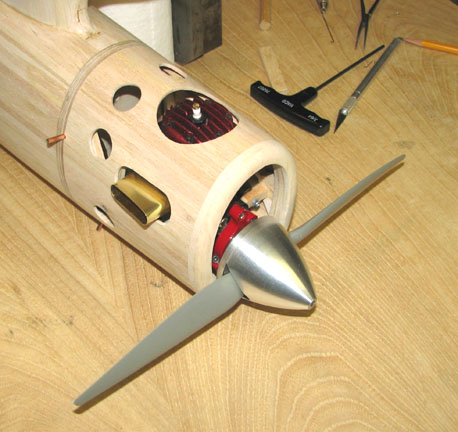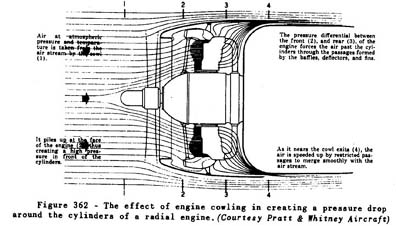Comet Sailplane
Project
Before I leave the issue cowl exit air venting, I
want to discuss the rationale to my approach on the Sailplane's cowl
summarize some of my thoughts on this subject. Engine cooling inside a
model's cowl is probably the most least understood facet of modeling. I
think that maybe back in the early days of control line speed, the die hard
speed modelers figured out how to build a cowl with venting to keep a
racing engine at satisfactory operating temperature for many revolutions
around the speed circle. However, that skill/art has been pretty much lost
today.
For the most part, very few SAM or free flight
models have completely cowled engines. For those that do have, the engine's
cylinder is exposed as shown below and engine cooling simply does not have
to be addressed.

There is one thing in our favor, our engine run
times are comparatively short (less than one minute).
Probably none of us know very much about engine
cooling inside of a cowl except that "more exit area is more cooling". As
you know I have been faced with addressing the issue of engine cooling
inside the Sailplane's cowl as shown below.

Having no real guide lines on how to go about
this, I decided to use the modeler's age old approach of "Gut Feel". I
selected a hole diameter of .8" because that provides a hole area of 1/2 sq.
in. I also selected a location for the holes well aft of the engine, but
about a fourth of the way forward from the cowl's aft bulkhead in order not
to weaken the back portion of the cowl too much. I tried to put as many
evenly spaced holes as possible in a ring around the cowl, but without
cutting through any of its internal structure. Therefore, the hole spacing
ended up some what irregular as is shown below.

This resulted in nine 1/2 sq. in. holes as shown
below. These nine holes provide a total area of 4.5 sq. in., not counting
the additional area around the cylinder head or exhaust.

The key question of course is this amount of exit
airflow area sufficient to keep the engine from over heating during the
relatively short power climb out? Since I did not know, I decided to ask for
the opinions of several life long experienced model builders. Their
responses to my question were most interesting and I think it is instructive
to share their various views with you, which are presented below.
************************************************************************************
Bob Angel
Looks workable to me Tandy. The only thing I might have done differently by "gut feel" would have been
Looks workable to me Tandy. The only thing I might have done differently by "gut feel" would have been
to place them almost all the way back inside
the cowl to eliminate possible stagnant air behind the vents.
Gene Wallock
You should have plenty of venting. The only way
to really tell is in the air. Remembering
back to the
McCoy 60 powered speed ships, I'd guess you've
got a lot more venting.
Larry Kruse
You are verging on overkill and should not be
worried about proper ventilation. Check out some of the old speed
models that used McCoy 60s. You'll find that
you probably have three or four times as much cooling as they had.
Bob Beecroft
Didn't most get
run for short FF motor runs with no vents with no ill effects? Probably
not an issue.
Jim O'Reilly
Only time
will tell for sure, but they look adequate to me.
Bob Holman
All I know is that it looks good. Should be
good enough to get the model almost out of site.
Gerald Martin
I thats plenty of
exit holes and you wont have any cooling problems especially with the
exhaust ducted outside.
Bill
Taylor
I think
you have more than enough venting. Donít worry any more.
Charlie Reich
I must say I'm not qualified to answer this
quandary. It appears to me that you have more than adequate venting. As
I recall most enclosed cowls in the old days have few, if any additional
vent holes. It seems the old-timers left the cyl. head out in the breeze
but the cylinder itself was pretty well enclosed in a tight cowl.Yours
looks good to me. Plenty of air exits!
Thomas Ryan
Ed Shilen used to say, the exiting area
should meet or exceed the air coming in. I don't
know how big the front of the cowl is but I
would say it is reduced by the size of the engine.
Jack Hiner
Many moons ago I was told or read that 4 times
the intake is what to use for exhaust when cooling engines and batteries.
Not sure of validity of this info?
James
Lollar
My gut
feeling, nothing scientific, says you have plenty of airflow in and around
the engine. Smart move on the irregularly spaced vent holes. I see no
reason to believe there will be heat build up of any significance in the
cowl. 4.5 sq. inches of vent should more than handle venting of all input
air. Airflow across the McCoy should be quite good.
Marvin Stern
An old
rule of thumb is that the area of the cooling air exit should be about
4 times
the inlet hole. I've used that for 60 years and never had a problem.
Jerry
Burk
I
didn't comment on your cowl cooling holes because I have no basis on which
to judge them. But it sure looks like enough to me! Any way to
instrument it? There are some little stick-on gadgets I have seen that
have heat ranges on the. I'll try to get more info on them.
Woody Bartelt
I do know that most
Sailplanes I have seen flying do so without the cowl. I suspect that
Goldberg had the cowl to make the ship look more attractive and for
selling purposes was not concerned either. All I can say is try it. If the
engine seizes up from over heating, you will know that id did not work.
Personally, I would probably put the cowl on for show and take it off for
flying. I think the cowl is less attractive with all of those holes in it.
Alfredo Herbon
(Late
Comment)
I didn't want to
make any comment to you, because my experience with cowled engines is
really poor and it is a very complex subject. I suppose the outlet area is
enough, but my unique concern with those holes distribution at some
distance forward ( I don't know how much ), from the firewall, is the
possibility of the generation of a localized air vortex that could alter
the air inlet into the venturi and alter the smooth running of the
McCoy when the model gains speed, but please take this just as an
"imaginative suspect", just that. As English men says : "The proof of the
pudding .... "
Surely your flying
test will have the last word, and in the worst case of a malfunction with
the cowl on, you could try some elongation backwards in a pair of holes
...
Charlie Reich
(Second Comment)
In all the responses I found it unusual that no one mentioned fuel. In
the old days 3 to 1 gas/oil mix was a given. In this day and age, in the
LMR events, most contestants use a mix of methanol and oil or Klotz 100,
in which the engines running methanol based fuel runs much cooler, which
would require less venting. So, the type of events the model flies in
could also have some effect on the amount of venting required.
Thomas Ryan
(Second
Comment)
Some Sailplane
flyers you may not have contacted:
Bob Oslan (Dooling 61)
Bruce Augustus (McCoy 60)
Larry Davidson (K&B)
Bill Schmidt (ST)
Furthermore, all of our comments seem to be starting with the presumption that the cowl impedes cooling which may or may not be true. When getting my private license, I saw some mechanics testing an engine with the cowl off and assuring all that this would be limited to avoid overheating. Their thought was that a properly designed cowl would channel the air and result in more cooling. Probably a lot more going on there than here.
Bob Oslan (Dooling 61)
Bruce Augustus (McCoy 60)
Larry Davidson (K&B)
Bill Schmidt (ST)
Furthermore, all of our comments seem to be starting with the presumption that the cowl impedes cooling which may or may not be true. When getting my private license, I saw some mechanics testing an engine with the cowl off and assuring all that this would be limited to avoid overheating. Their thought was that a properly designed cowl would channel the air and result in more cooling. Probably a lot more going on there than here.
Tandy Walker
(Late
Comment)
I read through a
couple of my college propulsion books on engine cooling the other evening.
As it turns out, aircraft designers configure cowl exits to generate a
pressure drop relative to the incoming air. This results in a venturi
effect that draws or sucks the air through the cowl and out into the free
stream as illustrated in the figure below. Therefore, in hind sight it
might have been better on the Sailplane to have put a radius around the
outside edge of the firewall in conjunction with an opening all the way
around the rear of the cowl structure. The cowl attachment to the firewall
would have had to be different for this type of an implementation however.
At any rate, I think this approach is something to consider on future
projects.

************************************************************************************
As you can see, the opinions varied quite a
bit, which was to be expected. However, taken collective, one gets a
feeling that there is probably enough exit airflow area to keep the
engine from over heating. So I will leave the cowl as it is for the
present time. However, after I get the new McCoy 60 broken in on the
bench, I will start the Sailplane's initial flight testing without the
cowl. Then once consistently good runs are achieved during the 35 second
climb out, I will install the cowl and evaluate the engine's performance
with the cowl. As Gene Wallock said,
"The only way
to really tell is in the air."
I realize that this discussion has little to
do with the Sailplane's construction, but maybe it will be of some help
to you if you ever completely cowl in an engine on one of your
models....................Tandy